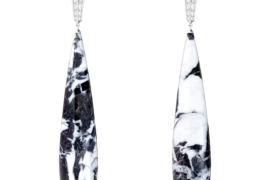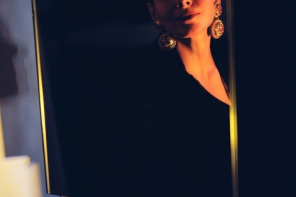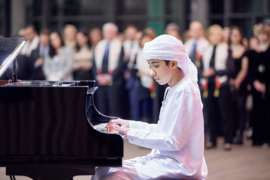A creative entrepreneur and a self-taught fashion designer, a mother of two, an art enthusiast, a humanitarian, and above all a lover of life, meet Faye Behbehani.
Like many renowned designers, you are self-taught. What was your learning process like?
When I first started my fashion practice I noticed a gap in Jeddah for young, fresh and creative styles. At the beginning it was the joy of mixing fabrics together and creating these beautiful garments. However, with time, I felt the need to understand the fundamentals of pattern making, sketching and sewing in order to create more elaborate collections. This made me take short courses in fashion design at the University of the Arts London, to help me develop those skills and excel in my brand and to take it to the next level.
My influences and inspirations from the fashion world come from houses like Etro, who have ethnic influences in their designs. As well as many established local Kuwaiti and Saudi designers like Saud Al Sabah, Aisha Al Fadhel, Mariam Al Bader and Razan Al Azzouni to name a few. But my main influence in designing Kaftans comes from the traditional Khaleeji Thobe. The Thobe, or Qamis, is an ankle length garment usually with long sleeves similar to a Kaftan worn in the Arabian Peninsula.
In my research for any collection I always start by looking at more traditional and ethnic pieces from different cultures of the MENA region. Some of my main resources are from the Metropolitan Museum, the British and the Victoria Museum and Albert Museum. I look for inspiration from their costume catalogues of pieces from Ethiopia, Palestine, Morocco and India.
Tell us more about Jasmine Box; what kind of brands do you sell? And what makes your boutique different from the competition?
Jasmine Box is a multi-brand store, one of the first to open in Jeddah. In 2006, the store opened as a concept store with both a focus on homewear and fashion. However, the idea of a concept store in 2006 was too advanced and customers were not able to engage in both design products from designers such as Nada Debs, Rachel Vosper, Gilles Caffier, Niki Jones, and at the time, up-and-coming designers such as Zimmerman, Charlotte Ronson, Alice & Olivia and Rebecca Taylor. The boutique had to shift and focus only on fashion, a direction that my partner Sara Mckinon and I took.
15 years later we are one of the trendiest stores in Jeddah. Keeping up with the latest fashion trends and stocking emerging fashion designers. I always try to find designers that are up-and-coming but also edgy. My personal style does influence the buying for the boutique as I find it an extension of myself. To describe my personal style, I would say I am bohemian, but also like to wear bright and bold patterns and the brands we carry reflect this style. I think this is what differentiates my boutique from the competition. Most of the items we carry in the store I would either wear or actually do have in my closet.
We carry a range of items from swimwear, to fashion wear, fashion accessories as well as our own range of Kaftans. Some of the current favorite brands are Love Shack Fancy, Carolina K, Marysia, Nimo and others from the US, Europe and Latin America. As a fashion buyer and designer when sourcing new brands I look at the supplier’s fashion ethics, are they sustainable and whether they follow ethical fashion practices?
You also established your own brand, how would you describe your fashion line?
The brand was born from the love of creation. My main fashion line is a Kaftan collection for Ramadan. However the Kaftans I design are versatile enough to be worn all year round. The brand is bold and known for its bright prints. I personally design each print myself. I have two lines of fabric: the printed silkscreen linen and traditional block printing. The silkscreen printing gives me more freedom to design any pattern. The latest collection is influenced by the Suzanis of Uzbekistan. Taking inspiration from old imagery of Uzbek Bukhara Suzanis, to create my own patterns and to print in bright bold colors. As for the block printing it is a little more complicated as the blocks themselves take a long time to develop because everything is done by hand. I work with an amazing team in Jaipur; always ready for the challenges and inspiration I bring to them every year. I love being able to continue this old craft tradition and tweak it to make it my own. The prints I use are the traditional Moghul floral and vegetal motifs, but in my own bold and bright colors which bring a new twist to the fabric.
A collaboration that I would like to talk about, and that I am proud of, was designing a few costume pieces and dressed the producer herself Mona Khashoggi for the Umm Kulthum & The Golden Era musical. This was my first time designing costumes and a lot of research went into the intricacy of designing to make them easy to take on and off during set changes, which was something new to me. The collection demonstrated the grandeur and glamour of Umm Kulthum. My main inspiration was her performance at the Olympia Theater in Paris, which was an iconic performance at the height of her career. Using lace, silks and jacquard fabrics to illustrate the glam of Arab women of her time.
Being a Kuwaiti working in Saudi Arabia and around the Arab gulf, would you say that each country has its particular clothing preference?
Kuwaitis are known for their sense of fashion and style and have always been avant-garde in the fashion world. As for Saudis, things are evolving with the many amazing changes that happened over the past two years, like the recent creation of the Fashion Commission, one of the 11 commissions working under the umbrella of the Kingdom’s Ministry of Culture. There has been a big shift in support by the government of Saudi Arabia to encourage and further develop local creative talent. With the introduction of fashion magazines, where in the past censorship and the lack of visual imagery was difficult to influence the fashion style of an individual.
At the beginning of my fashion career I would design separate collections for the different clients and spaces I would exhibit or display in the GCC. However, I find that this gap is bridging.
And what are young Saudi women purchasing the most?
The style of young Saudi women has definitely changed over time. Especially when it comes to the more traditional items such as Abayas and Kaftans. They are now more open to wearing Kaftans that are not as traditional and more stylish. Being more accepting of wearing colored Abayas or wearing shorter length and short sleeve Kaftans for Ramadan.
Mothers often feel that they are obliged to put their careers on pause, how are you able to juggle motherhood and work?
Becoming a mother has been one of the greatest blessings of my life. It taught me to love selflessly and always put my children’s needs first. I never felt obliged to put my career on pause. Being a mother in itself entails wearing many hats and playing different roles whether it is physically caring for your newborn, or taking care of the household, managing schedules and dropping off kids at various activities, something any mother can relate to. You learn to be a great project manager and each and all of us mothers are our own individual project managers. I am blessed to have managed to create balance and harmony between my motherhood and work life.
My children are also involved in my work. Since they were young I would take them with me to the store and have them help out, whether it is sitting behind the counter and bagging customer’s purchases, or more recently on our latest photoshoot where I took my 11 year-old daughter and her two best friends to help me set-up and style the shoot. This was an experience they loved and would cherish for the rest of their lives. And hopefully influence them positively in their future decisions of their studies and career.
In the period before it was normalized to work from home, I used to do all my emails and fashion orders from my laptop at home or even in the car on the way to pick up and after dropping off the kids to school (this of course was before the time women could drive). I continue to design my collections and work from home as opposed to having a studio that I work out of. This gives me the flexibility to work and be present in my kids’ everyday life especially as they are now in their second year of homeschooling.
On top of it, you are involved in The Barakat Trust, tell us more about it and some of its key accomplishments so far
The Barakat Trust was founded as a UK charity in 1987 and operates for educational and heritage purposes focusing on the heritage of the Islamic world. We provide scholarships and grants for study and research projects at the world’s most respected academic and cultural institutions at post-graduate and postdoctoral level. We support conservation and documentation work, travel for research and education, training programs, including the training of conservation professionals and curators. Over the past 30 years, we have invested resources in building the skills of heritage professionals and supporting projects in 40 countries. Many of our grantees have long-standing relationships with The Trust, developed over decades. On the other hand, we are open and welcome new partnerships, new ideas, and new generations. For the past ten years my work with the Barakat Trust engages with membership development and has been an integral part of organizing cultural events including workshops, cultural trips, lectures, exhibitions, concerts, craft fairs and gala dinners. In April 2020 I had the honor and privilege to sit as a Trustee member of the Trust.
Finally, what are you currently working on?
I am working on a more sustainable brand. At the heart of our business we are focused on sustainability by responsibly sourcing materials and thoughtful manufacturing. The label extends its philosophy of kindness to commitment of fair pay and working conditions for the craftspeople working on each piece. From fabric production to garment creation, these jobs provide a reliable and stable income for individuals who may not have received such opportunities.
In terms of my fashion work I am currently in the middle of launching our latest Ramadan 2021 collection. This current collection was designed during lockdown, in the absence of any physical journeys many of us had to go inwards or reflect upon the past. This collection has been inspired by past travels to both Jaipur and Marrakesh. As I designed the looks I had an image of a bohemian traveler wandering through the souks and being dreamy in the absorption of her surroundings. There is a blend of both cultures born into the design of the garments. This will be our most sustainable collection so far. We have minimized on printing and production of new fabric to reduce our carbon footprint. Which has led me to design a collection that incorporates previous season’s fabrics intrinsically woven into our new pieces to minimize excess fabric waste. This is a practice I have noticed more and more in designers, not wasting any unused fabric. The Jasmine Box creation is a timeless piece and can be worn over and over again.
My vision for the label is to continuously grow and evolve through innovative and creative design, all while still maintaining the brand’s integrity and ethos at heart.
Text by Victor Gee







